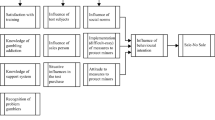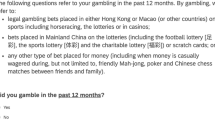Abstract
Factors associated with lottery ticket purchases, accessibility of lottery products, and lottery playing behaviour amongst 1,072 youth (ages 10–18 years old, mean age 14 years-old) was examined. Playing the lottery was found to be the most popular gambling activity with youth reporting playing all forms of lottery tickets including draws, scratch tickets, and sports lottery tickets. Youth reported beginning to play the lottery at age 12, with scratch ticket participation being amongst the most highly reported type of lottery activity with the youngest age of onset. The vast majority of youth are aware of the legal age to purchase tickets although many believed that there should be no age requirement to purchase any form of lottery ticket. Youth, regardless of their age, reported few if any difficulties in purchasing lottery tickets. Moreover, a third of underage youth reported going to the store specifically to purchase lottery tickets with this behaviour increasing with the age of the participant. This research confirms previous findings that lottery tickets are highly accessible to underage youth despite legal prohibitions. The results provide valuable information that can be subsequently used in the development of responsible social policy and youth gambling prevention programs
Similar content being viewed by others
REFERENCES
Azimer, J. (2000). Canadian gambling behaviour and attitudes. Gambling in Canada Research Report (No. 8), Calgary: Canada West Foundation.
Browne, B. A., & Brown, D. J. (1994). Predictors of lottery gambling among American college students. The Journal of Social Psychology, 134, 339-347.
Canadian Foundation on Compulsive Gambling (Ontario). (1994). An exploration of the prevalence and pathological gambling behaviour among adolescents in Ontario. Toronto: Insight Canada Research.
Clotfelter, C. T., & Cook, P. (1987). Selling hope: State lotteries in America. Cambridge, Mass: Harvard University Press.
Custer, R. L., & Milt, H. (1985). When luck runs out. New York: Facts on File Publications.
Dell, L. J., Ruzika, M. F., & Palisi, A. T. (1981). Personality and other factors associated with gambling addiction. International Journal of Addictions, 16, 149-156.
Derevensky, J. L., & Gupta, R. (1998a, June). Youth gambling: Prevalence, risk factors, clinical issues, and social policy. Paper presented at the annual meeting of the Canadian Psychological Association, Edmonton, Alberta.
Derevensky, J. L., & Gupta, R. (1998b). Work in progress: Child and adolescent gambling problems: A program of research. Canadian Journal of School Psychology, 14, 55-58.
Felsher, J. R., Derevensky, J L., & Gupta, R. (2003). Parental influences and social modelling of youth lottery participation. Journal of Community and Applied Social Psychology, 13, 361-377.
Felsher, J. R.,Gupta, R., & Derevensky, J L. (2001, June). An examination of lottery ticket purchases by minors. Paper presented at the annual meeting of the National Council on Problem Gambling, Seattle, Washington.
Garner, C. (1995, June)). It could be YOUR child. The Sunday Mirror, pp. 4-5.
Govoni, R., Rupcich, N., & Frisch, G. R. (1996). Gambling behaviour of adolescent gamblers. Journal of Gambling Studies, 12, 305-318.
Griffiths, M. D., & Dunbar, D. (1997). The role of familiarity in fruit machine gambling. Society for the Study of Gambling Newsletter, 29, 15-20.
Griffiths, M. D., & Wood, R. T. (1999). Lottery gambling and addiction: An overview of European research: Paper presented at the Association of European National Lotteries (AELLE), Lausanne, Switzerland.
Gupta, R., & Derevensky, J. L. (1996). The relationship between gambling and video game playing behaviour in children and adolescents. Journal of Gambling Studies, 12, 375-394.
Gupta, R., & Derevensky, J. L. (1998a). Adolescent gambling behaviour: A prevalence study and examination of the correlates associated with problem gambling. Journal of Gambling Studies, 14, 319-343.
Gupta, R., & Derevensky, J. L. (1998b). An empirical examination of Jacob's General Theory of Addictions: Do adolescent gamblers fit the theory? Journal of Gambling Studies, 14, 17-49.
Huxley, J., & Carroll, D. (1992). A survey of fruit machine gambling in adolescents. Journal of Gambling Studies, 8, 167-179.
Independent Television Commission (1995). Child's eye-view. Spectrum, 17, 24.
Jacobs, D. F. (2000). Juvenile gambling in North America: An analysis of long-term trends and future prospects. Journal of Gambling Studies, 16, 119-151.
Kaplan, R. (1989). State lotteries: Should government be a player? In H. J Shaffer, S. A. Stein., B. Gambino., & T.N Cummings. (Eds.), Compulsive gambling: Theory, research and practice. Lexington Books, Boston, Massachusetts.
Korn, D., & Shaffer, H. J. (1999). Gambling and the health of the public: Adopting a public health perspective. Journal of Gambling Studies, 15, 289-365.
Ladouceur, R. (1996). The prevalence of pathological gambling in Canada. Journal of Gambling Studies, 12, 129-142.
Ladouceur, R., & Mireault, C. (1988). Gambling behaviour among high school students in the Quebec area. Journal of Gambling Behaviour, 4, 3-12.
Lesieur, H. R., & Klein, R. (1987). Pathological gambling among high school students. Addictive Behaviours, 12, 129-135.
Lottery Insights (2001). Ontario Lottery and Gaming Corporation (OLGC) advertising. The Official Publication of the North American Association of State and Provincial Lotteries, 2(3), 16-18.
Macdonald, M. (1995, May). Shopkeepers break ban on child gamblers. The Independent, p. 3.
Moran, E. (1995). Majority of secondary school children buy tickets. British Medical Journal, 311, 1225-1226.
National Research Council (1999). Pathological gambling: A critical review. Washington, D.C.: National Academy Press.
Parke, J. & Griffiths, M. D. (2001, February). The psychology of the fruit machine: The role of structural characteristics (revisited). Paper presented at the future of slot machines in the UK conference, London, England.
Saunders, Carol Silverman. (1999). Straight talk about teenage gambling. Facts on File Publications, New York.
Shaffer, H. J., & Hall, M. N. (1996). Estimating the prevalence of adolescent gambling disorders: A quantitative synthesis and guide toward standard gambling nomenclature. Journal of Gambling Studies, 12, 193-214.
Shaffer, H. J., & Hall, M. N. (2001). Updating and refining prevalence estimates of disordered gambling behaviour in the United States and Canada. Canadian Journal of Public Health, 92, 168-172.
Shaffer, H. J., & Zinberg, N. E. (1994). The emergence of youthful addiction: The prevalence of underage lottery use and the impact of gambling. Technical Report for the Massachusetts Council in Compulsive Gambling (011394-100).
Stinchfield, R., & Winters, K. C. (1998). Gambling and problem gambling among youth. Annals of the American Academy of Political and Social Science, 556, 172-185.
Volberg, R. H., & Moore, W. I. (1999). Gambling and problem gambling among adolescents in Washington State: A replication study, 1993–1999. A report to the Washington State Lottery. Gemini Research.
Walker, M. B. (1992). The psychology of gambling. Oxford, Butterworth-Heinermann Ltd.
Westphal, J. R., Rush, J. A., Stevens, L., & Johnson, L. J. (1998a, August). Pathological gambling among Louisiana students: Grades six through twelve. Paper presented at the American Psychiatric Association Annual Meeting. Toronto, Canada.
Winters, K. C., Stinchfield, R. D., & Kim, L. G. (1995). Monitoring adolescent gambling in Minnesota. Journal of Gambling Studies, 11, 165-183.
Wood, R, T., & Griffiths, M. D. (1998). The acquisition, development, and maintenance of lottery and scratchcard gambling in adolescence. Journal of Adolescence, 21, 265-273.
Wood, R. T., & Griffiths, M. D. (2001). Adolescent lottery and scratchcard players: Do their attitudes influence their gambling behaviour? Social Psychology Review, 3, 48-56.
Wynne, H. J., Smith, G. J., & Jacobs, D. F. (1996). Adolescent gambling and problem gambling in Alberta. Prepared for the Alberta Alcohol and Drug Abuse Commission. Edmonton: Wynne Resources LTD.
Author information
Authors and Affiliations
Corresponding author
Rights and permissions
About this article
Cite this article
Felsher, J.R., Derevensky, J.L. & Gupta, R. Lottery Playing Amongst Youth: Implications for Prevention and Social Policy. J Gambl Stud 20, 127–153 (2004). https://doi.org/10.1023/B:JOGS.0000022306.72513.7c
Issue Date:
DOI: https://doi.org/10.1023/B:JOGS.0000022306.72513.7c




